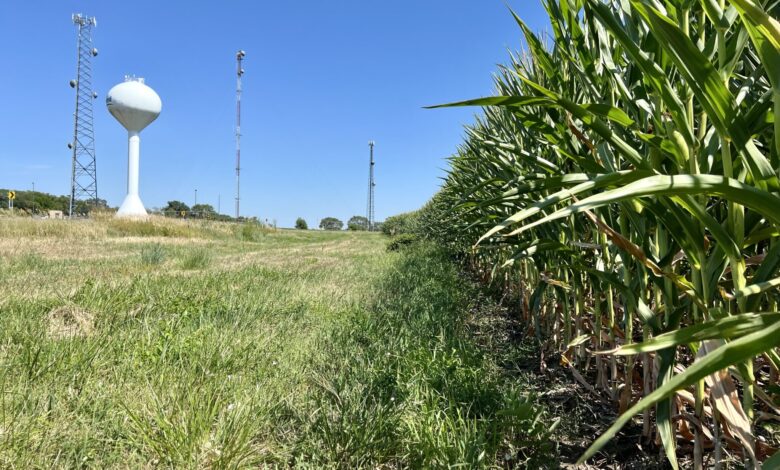Congress talks nonsense, farmers struggle in ‘bleak’ situation

Fertilizer costs rise; crop prices fall. Farmers are struggling with drought and ranch owners are selling off large swathes of their cattle.
Most importantly, Congress has yet to pass new legislation farm billThe bill expires on Monday, and action on the sweeping legislation, which provides everything from nutrition assistance to farm disaster recovery assistance, is unlikely before the end of the year.
Slow legislative action is not unusual, but as farm incomes continue to decline, producers are struggling to make ends meet. Tim Gibbons, communications director for the Missouri Rural Crisis Center, noted that it currently costs more to grow a bushel of corn than farmers make when selling it.
In the months after Russia invaded Ukraine, the prices farmers received for staple food crops such as corn and soybeans fell 20% to 40% from their highs in 2022, USDA data shows. But Gibbons said the spike was an anomaly.
“We haven’t had very high prices for decades… and this really provides long-term support to farmers so that they can not only stay on the farm but pass it on to the next generation,” Gibbons said.
University of Missouri researchers Farm income next year is expected to be 35% lower than the peak level in 2022.
“Farmers are going to be in a more stressful situation than they have been in the past three years and they have to be more cognizant of having a very strategic marketing plan to get good cash flow,” said senior farmer Bob Maltsburger. Research Economist at the Institute for Food and Agricultural Policy.
competition for funds
The “bleak” state of the farm economy, as Republican Sen. Jerry Moran of Kansas put it, has farm groups and heartland lawmakers clamoring for an updated farm bill. But partisan gridlock in Washington, D.C., and tensions over which projects to prioritize in the massive bill have made it difficult for lawmakers to find common ground.
"We need a farm bill," Moran told the Senate earlier this month“Even the current one, but the current one, is not enough to meet the demands on farmers’ incomes across the country from the ongoing disaster.”
this farm billThe program, the primary tool for U.S. food and agricultural policy, is set to expire on September 30. said it was necessary to allow the plan to be implemented. Moran urged colleagues to extend the existing farm bill while a more thorough rewrite remains to be done.
The bill’s largest spending — about 75 percent — supports various programs to combat food insecurity, including the Supplemental Nutrition Assistance Program (SNAP), commonly known as “food stamps.” Its other signature programs include crop insurance and support for farmers when crop prices are low. The legislation also provides funding to encourage conservation and more sustainable agriculture.
At the center of this year’s debate is how to permanently increase spending on: Conservation and climate-friendly practices. Congress previously provided $20 billion through the Inflation Reduction Act of 2023 to help farmers plant cover crops and trees; alternate grassland fallow grazing and restore wetlands.
Andrew Lentz, director of agricultural policy at the Environmental Protection Fund, said the funding has helped more farmers participate in historically underfunded conservation programs. He said his organization hopes Congress will take advantage of this “tremendous opportunity” to make these funding levels permanent.
climate focus
While Democrats want to ensure the funds go toward practices that reduce greenhouse gas emissions from agriculture, the demands have not received support from Republican-controlled U.S. House committees.
“If Congress can do this, they will be able to maintain these higher funding levels and maintain the climate focus of these funds to address the root causes of climate change and … help farmers develop new resources,” Lentz said. Low-carbon agricultural products market. “
But Jennifer Ift, an associate professor at Kansas State University, said Congress cannot increase the federal deficit when passing a new farm bill, which has led to tensions among lawmakers over how to prioritize projects. U.S. House Republicans support increasing funding for a farm safety net that supports farmers when crop prices are low.
Ift said it was hard enough to do that this year, but it will be even harder to do so next year as crop prices are expected to continue falling, increasing the cost of the safety net.
“Compromising may not get easier,” Ift said.
The House Republican version of the bill also cuts $30 billion in nutrition assistance, which is a no-go for Democrats.
U.S. Sen. Debbie Stabenow, D-Mich., chair of the Senate Agriculture Committee, called the bill and Senate Republicans’ “framework” of the farm bill “flawed,” noting that it cuts nutrition budget and “deviate from the progress we have made.” Efforts are being made to combat the climate crisis. “
Gibbons said better options to help boost crop prices are missing from the conversation. He believes that managing supply and adjusting decisions to meet market demand are low-cost alternatives to ensuring farmers receive a fair price for their crops. But that’s not part of the policy discussion, he said.
“The battle is once again, ‘How far are we going to go to feed hungry people who need food,'” Gibbons said.
This article was first published in missouri independentis the Nebraska Examiner’s sister site in the national newsroom network.
